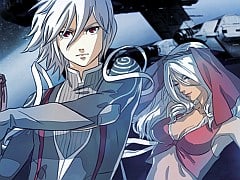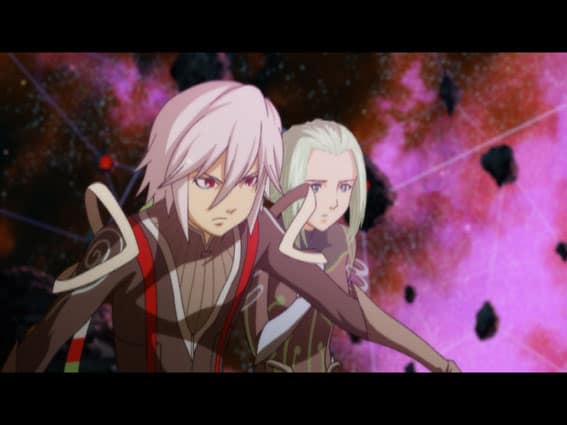You can trust VideoGamer. Our team of gaming experts spend hours testing and reviewing the latest games, to ensure you're reading the most comprehensive guide possible. Rest assured, all imagery and advice is unique and original. Check out how we test and review games here
Infinite Space brings together two of my favourite things in life: JRPGs and space-opera. For those with geek-levels matching my own, such a combination is irresistible. While Mass Effect’s allegiances lie firmly with western RPG mechanics, and the Star Ocean series only really uses space as a setting in the pseudo sense, Infinite Space brings the two components together seamlessly. In layman’s terms, it’s Final Fantasy meets Battlestar Galactica; the beautiful amalgamation of eastern role playing mechanics, starships and the melodramatic politics of advanced civilisations.
Half an hour in, and my hopes had been well and truly dashed. The graphics were scrappy, the main character was brimming with the clichés of an RPG protagonist, the story had yet to take a cohesive form, the visuals lacked continuity, and the battle system was a befuddling bore. The only solace I found was at the thought of the scathing review I would later write. With my mind already putting together some delightfully derogatory remarks, I begrudgingly played on. To my joy (and also disappointment), I found that the game got better. Significantly better. Normally my snap judgements are well founded, but this time I’m happy to admit I was wrong.
The turning point was shortly after I became captain of my very own battle ship, which I named Pegasus. As any Star Trek or Battlestar Galactica fan can imagine, taking command of not only a starship, but an entire armada of vessels willing to exact your every command is an alluring prospect indeed. Before explaining the stunning amount of depth available to the commander of just such a fleet, I should probably explain the events leading up to the young protagonist’s acquisition of such a responsibility.
In the distant future of an unknown universe, a planet called Ropesk is imprisoned by the laws of an iron-fisted feudal lord, its inhabitants forbidden to travel into space. Our ambitious hero Yuri has no intentions of conforming to such laws, however, and enlists the help of somebody known as a ‘Launcher’ to help him escape. Enter Nia; a busty intergalactic guide with the perfect set of skills to stage just such a rescue mission. With the infinite chasm of space at his disposal, Yuri intends to investigate the Epitaph – a strange heirloom passed onto him from his late father.
While initially the story failed to spark my interest, the more time I spent with the game, the more interested I became in the fate of the characters. Yuri might not be the most original character ever conceived, but he’s developed incredibly well, and the story that unfolds around him is expertly crafted. It had to be though; you never actually take control of Yuri at any point, meaning that progression is all menu and text based. A well written script was therefore vital, and Infinite Space thankfully does not disappoint, with a cast of interesting characters brought to life through pleasant anime artwork and solid dialogue.
It isn’t long after escaping Ropesk that Yuri acquires a ship of his own, and the game is blown wide open. With money earned from battles and jobs, Yuri can buy blueprints for new ships, remodel existing vessels and recruit a crew in an intergalactic equivalent to the excellent Suikoden series. If you’re struggling to imagine how the game plays minute-to-minute, I’ll paint the picture for you. You travel from planet to planet along set routes defined on the bottom screen of your DS. Along the way, you’ll be interrupted by space pirates and other nefarious space travellers, and gameplay switches to that of the unique battle system. Once you reach your destination, you can repair your ship, advance the plot by speaking to characters at taverns, or kit out your ship with new weapons and crew members.
The battle system is a curious affair; quite unlike anything I’ve played before. First and fore mostly, your battle combatants are not characters, but ships (although there are melee battles later on in the game). With some 150 odd vessels that can be bought, named and customised, the starships of Infinite Space are your ‘party’. Characters are purely a means to increase the effectiveness of each ship, and don’t affect combat directly. In battle, the bottom screen plays host to a range of commands available to your ship, and the top screen shows the action from the perspective of the ship’s command deck.
A horizontal meter at the top of the screen shows your position relative to the enemy. The distance between your ship and theirs is crucial, with different commands becoming available depending on your position. The three commands available at the beginning of the game are Dodge, Normal and Barrage, the equivalent of Rock, Paper and Scissors. If you think your enemy is preparing a lethal Barrage attack, use the Dodge command to avoid the attack completely. If, however, they launch a normal attack after you’ve selected Dodge, the damage will be critical. This of course works to your advantage too. While at first this system appears to rely on thoughtless guesswork, a greater degree of depth is revealed after extended play.
A gauge on the left of the screen determines what attacks are available, filling through phases of green, yellow and red. Dodge, Normal and Barrage attacks become available respectively, and knowing when to use each is crucial for success. With harder battles, the enemy ship icon on your command screen becomes increasingly important, and will appear green, yellow or red based on its own gauge. Knowing the status of your enemy allows for tactical based play, reducing the need for idle guesswork.
Even with an unconventional battle system such as this, the game still allows players to slip into the comfortable grind of repeated fights in order to become stronger. Whenever you’re not jetting from planet to planet fighting space pirates, chances are you’ll be tinkering around in menus to fine tune the effectiveness of your fleet. The ship customisation is ludicrously in depth, offering countless ways to improve the performance of your fleet. You can buy and equip new weapons, and rearrange the very layout of the ship by moving modules about a virtual representation of the ship (think inventory organisation in Resident Evil 4, only with rooms aboard a starship).
A ship is nothing without a crew, however, and thankfully Infinite Space provides the means to recruit one. Much like Suikoden and its 108 Stars of Destiny, the universe of Infinite Space features over 200 employable characters, all of which can be assigned to specific roles within the fleet. This ranges from lieutenants and officers to security officers and chefs, and each character has their own back-story relevant to the game world. Hunting down the most efficient characters to fill a position is an addictive challenge, although their role in your fleet has already been predetermined by their stats. You’re not likely to assign somebody with high proficiencies in cooking as anything else other than a chef, freewill is nothing more than a fancy illusion – but the feature is welcome nonetheless.
Be aware that the game is punishingly hard. Unless you know exactly what you’re doing in battle, you’ll find yourself staring at the Game Over with depressing frequency. The tutorial at the start of the game might put players on the right track, but it does little to explain the daunting options available at the customisation level. To learn everything the game has on offer simply takes time, but with around 60 hours of game to play through, there’s more than enough to master the intricacies of the mechanics.
Even at the height of my enjoyment with the game, some of the problems I outlined at the start of the review failed to disappear. Visually, Infinite Space is disappointing; battle animations are particularly poor, failing to compliment the grand scale of space battle. The lack of a mission log proves frustrating, too, especially in a game with a scope as huge as Infinite Space. Often you’ll not know what you’re looking for, or even where to look for it. Purely on the surface, Infinite Space appears to be a second-rate JRPG, as my first impressions of the game proved.
With a little investment of time, however, Infinite Space’s flaws can be easily ignored; sucked into the familiar black hole that all addictive RPGs seem to possess. To scale such an epic romp through the vastness of space onto a handheld console is an impressive feat, and the game certainly puts an interesting spin on the tired JRPG formula. A few flaws hold the game back from greatness, but JRPG fans with a penchant for space-opera would be wise to check this one out.
Infinite Space
- Platform(s): Nintendo DS
- Genre(s): Adventure, RPG, Simulation, Third Person

/https://oimg.videogamer.com/images/bd89/infinite_line_5.jpg)
/https://oimg.videogamer.com/images/29de/infinite_line_1.jpg)
/https://oimg.videogamer.com/images/1a98/infinite_line_4.jpg)






